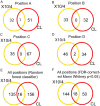Spatial metabolomics identifies localized chemical changes in heart tissue during chronic cardiac Chagas Disease
- PMID: 34606502
- PMCID: PMC8516257
- DOI: 10.1371/journal.pntd.0009819
Spatial metabolomics identifies localized chemical changes in heart tissue during chronic cardiac Chagas Disease
Abstract
Chagas disease (CD), caused by the parasite Trypanosoma cruzi, is one of nineteen neglected tropical diseases. CD is a vector-borne disease transmitted by triatomines, but CD can also be transmitted through blood transfusions, organ transplants, T. cruzi-contaminated food and drinks, and congenital transmission. While endemic to the Americas, T. cruzi infects 7-8 million people worldwide and can induce severe cardiac symptoms including apical aneurysms, thromboembolisms and arrhythmias during the chronic stage of CD. However, these cardiac clinical manifestations and CD pathogenesis are not fully understood. Using spatial metabolomics (chemical cartography), we sought to understand the localized impact of chronic CD on the cardiac metabolome of mice infected with two divergent T. cruzi strains. Our data showed chemical differences in localized cardiac regions upon chronic T. cruzi infection, indicating that parasite infection changes the host metabolome at specific sites in chronic CD. These sites were distinct from the sites of highest parasite burden. In addition, we identified acylcarnitines and glycerophosphocholines as discriminatory chemical families within each heart region, comparing infected and uninfected samples. Overall, our study indicated global and positional metabolic differences common to infection with different T. cruzi strains and identified select infection-modulated pathways. These results provide further insight into CD pathogenesis and demonstrate the advantage of a systematic spatial perspective to understand infectious disease tropism.
Conflict of interest statement
The authors have declared that no competing interests exist.
Figures




Similar articles
-
Cardioprotective actions of curcumin on the pathogenic NFAT/COX-2/prostaglandin E2 pathway induced during Trypanosoma cruzi infection.Phytomedicine. 2016 Nov 15;23(12):1392-1400. doi: 10.1016/j.phymed.2016.06.017. Epub 2016 Jun 29. Phytomedicine. 2016. PMID: 27765359
-
Molecular identification of Trypanosoma cruzi discrete typing units in end-stage chronic Chagas heart disease and reactivation after heart transplantation.Clin Infect Dis. 2010 Sep 1;51(5):485-95. doi: 10.1086/655680. Clin Infect Dis. 2010. PMID: 20645859
-
Expression and production of cardiac angiogenic mediators depend on the Trypanosoma cruzi-genetic population in experimental C57BL/6 mice infection.Microvasc Res. 2017 Mar;110:56-63. doi: 10.1016/j.mvr.2016.12.002. Epub 2016 Dec 9. Microvasc Res. 2017. PMID: 27956355
-
The role of parasite persistence in pathogenesis of Chagas heart disease.Parasite Immunol. 2009 Nov;31(11):673-85. doi: 10.1111/j.1365-3024.2009.01108.x. Parasite Immunol. 2009. PMID: 19825107 Review.
-
Myocardial gene and protein expression profiles after autoimmune injury in Chagas' disease cardiomyopathy.Autoimmun Rev. 2011 Jan;10(3):163-5. doi: 10.1016/j.autrev.2010.09.019. Epub 2010 Sep 29. Autoimmun Rev. 2011. PMID: 20883825 Review.
Cited by
-
Dysregulation of Glycerophosphocholines in the Cutaneous Lesion Caused by Leishmania major in Experimental Murine Models.Pathogens. 2021 May 13;10(5):593. doi: 10.3390/pathogens10050593. Pathogens. 2021. PMID: 34068119 Free PMC article.
-
Mass spectrometry-based metabolomics approaches to interrogate host-microbiome interactions in mammalian systems.Nat Prod Rep. 2025 Jun 16. doi: 10.1039/d5np00021a. Online ahead of print. Nat Prod Rep. 2025. PMID: 40521991 Free PMC article. Review.
-
It takes two to tango: How immune responses and metabolic changes jointly shape cardiac Chagas disease.PLoS Pathog. 2023 Jun 1;19(6):e1011399. doi: 10.1371/journal.ppat.1011399. eCollection 2023 Jun. PLoS Pathog. 2023. PMID: 37262078 Free PMC article. No abstract available.
-
Persistent biofluid small molecule alterations induced by Trypanosoma cruzi infection are not restored by antiparasitic treatment.bioRxiv [Preprint]. 2023 Jun 3:2023.06.03.543565. doi: 10.1101/2023.06.03.543565. bioRxiv. 2023. Update in: ACS Infect Dis. 2023 Nov 10;9(11):2173-2189. doi: 10.1021/acsinfecdis.3c00261. PMID: 37425694 Free PMC article. Updated. Preprint.
-
System-based insights into parasitological and clinical treatment failure in Chagas disease.mSystems. 2025 Feb 18;10(2):e0003824. doi: 10.1128/msystems.00038-24. Epub 2025 Jan 7. mSystems. 2025. PMID: 39772644 Free PMC article. Review.
References
-
- Bern C. Chagas’ Disease. The New England journal of medicine. 2015. p. 1882. - PubMed
Publication types
MeSH terms
Substances
Grants and funding
LinkOut - more resources
Full Text Sources

